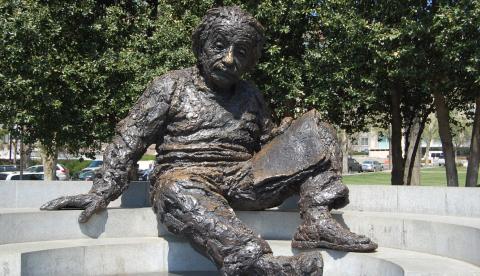On Friday, October 23, as thousands of alumni and students converge on campus to celebrate homecoming, we will officially dedicate the final cast of Robert Berk’s Einstein sculpture right here on campus. Georgia Tech and Atlanta embody science and civil/human rights like no other institution and city in the nation. It is fitting that we will be the home of this unique piece of public art. Unquestionably, the Einstein Monument at Georgia Tech will become a fitting icon for what we represent: science, technology and the betterment of the human condition.
Last week, we hosted the Office of the Arts Advisory Board meeting, bringing together staff, alumni, and friends of Georgia Tech who share a love for the arts, but also a vision for how the variety of arts programming at Georgia Tech can inspire, excite, and enrich the student experience. In the words of Russell Medford, MD, one of our board members, the Arts@Tech initiative is about ”producing a new global citizen that is multi-dimensional in thought, capable of redefining science and art of the possible, and is committed to building a better world.” In just a few short years, the initiative has spearheaded many efforts from the acquisition of public art now visible around the campus, a partnership with the ArtCrawl and a reinvigorated Margaret Guthman Musical Instrument Competition, to special exhibits of various kinds, and new and unique musical and theatrical performances.
The latest of these initiatives is the recent acquisition of the final cast of Robert Berks’ monument to Albert Einstein. The other installations of Berks’ sculptures of Einstein are located at the National Academy of Sciences in Washington, D.C. and the Israel Academy of Sciences and Humanities in Jerusalem. On Friday, October 23, as thousands of alumni and students converge on campus to celebrate homecoming, we will officially dedicate the final cast of Berk’s Einstein sculpture right here on campus.
Atlanta resident and Berks collector, Jim Barksdale, first brought the idea to Georgia Tech after learning the final cast was available. Jim was particularly passionate about Einstein’s legacy as a human rights advocate, and thought Atlanta and Georgia Tech represented the perfect place for the cast to call its new home. We couldn’t agree more, and Jim’s generous cornerstone gift was instrumental in bringing Einstein to Georgia Tech.
Einstein was so much more than one of the 20th century’s most brilliant and original physicists, he was also a tireless and highly visible advocate for peace and social justice. Georgia Tech and Atlanta embody science and civil and human rights like no other institution and city in the world. It is fitting that we will be the home of this unique piece of public art. The monument consists of a larger-than-life bronze of the famous scientist holding a book with the famous equations that brought together energy and matter and space and time – effectively redefining physics, and reminding us that we are just one small expression of an extraordinary universe whose beginning and end we still seek to understand.
The design of a sitting Einstein and the science allegory is common to all three existing monuments. But our Einstein is unique in that he gazes down to a black granite platform with the exact replica of the night sky over Atlanta on December 10, 1948 – the day of the signing of the Universal Declaration of Human Rights.
Engraved on the granite steps are two quotes representing Einstein the scientist and the humanist. Most fittingly, one of the quotes is pulled from Article I of the Universal Declaration of Human Rights and reads, “All human beings are born free and equal in dignity and rights."
The excitement surrounding the Einstein project has been, in my experience, unprecedented. What began as an idea, quickly transitioned into a highly successful campaign for resources, and the support continues. Honestly, I have never seen a project generate this much support in such a small amount of time. Many friends and alumni followed Jim Barksdale’s example and donated generously to the effort, sufficient to cover all costs and hopefully, as it continues, to fund annual programs around the subject matter that the monument evokes.
The Class of 1966 recently voted to make the project the subject of their 50th year class gift. Their initial goal was reached the day they made the decision. Fittingly they have decided to raise the goal, which will make all our aspirations for the impact of the Einstein piece on the campus and community come true.
Unquestionably, the Einstein Monument at Georgia Tech will become a fitting icon for what we represent: science, technology and the betterment of the human condition.
